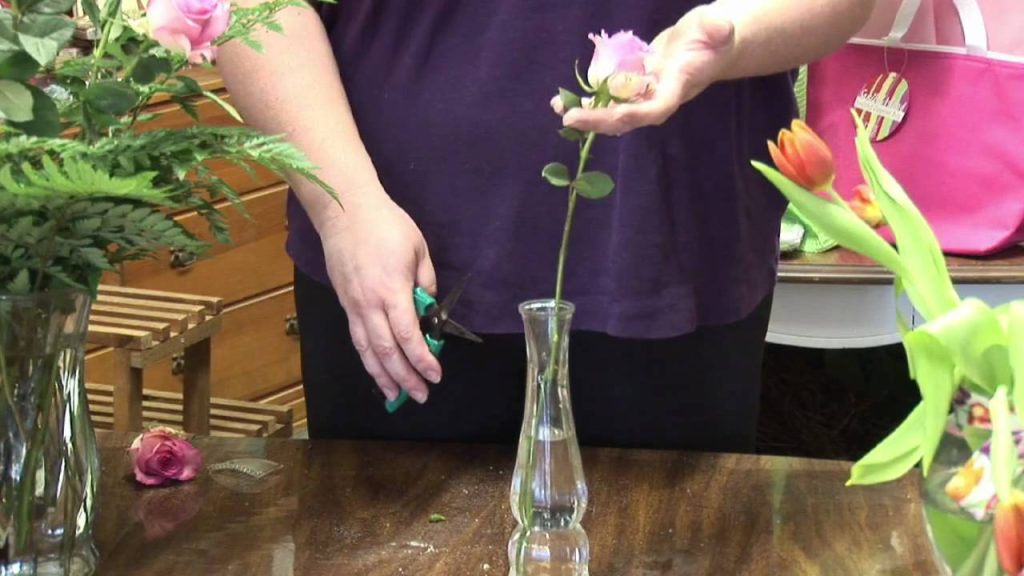Flowers are a beautiful way to brighten a room, adding a touch of nature and cheer. But unfortunately, their vibrancy doesn’t last forever. As the days pass, you might notice your once-perky petals drooping and their colors fading. Don’t despair! With a few simple techniques, you can often revive wilting flowers and extend their lifespan in your vase.
Fresh Start: Cleaning and Prepping
Before diving into reviving techniques, let’s ensure the foundation is clean. Start by thoroughly washing your vase with warm, soapy water. This removes any lingering bacteria that could shorten the life of your flowers. Rinse the vase well to remove any soap residue.

Snip, Sip, Repeat: Stem Maintenance
Flowers take in water through their stems. Over time, the cut ends can become clogged, hindering this vital process. To refresh the water uptake, use sharp pruners or shears to cut off about an inch from the bottom of each stem at an angle. This creates a larger surface area for water absorption. Repeat this process every few days to maintain optimal water intake.
Water Woes: The Importance of Hydration
Wilting flowers are often thirsty flowers. Check the water level in your vase regularly and ensure the stems are submerged at least halfway up. Use lukewarm water, as very hot or cold water can be shocking to the blooms.

Cleanliness is Key: Banishing Bacteria
Stagnant water can become a breeding ground for bacteria, further shortening the life of your flowers. To combat this, completely replace the vase water every few days. While emptying the vase, rinse the stems again to remove any built-up slime.
A Touch of Science: Flower Food or DIY Solutions
Many commercially available flower foods contain a combination of sugar, acid, and bleach. Sugar provides nourishment to the flowers, while the acid helps regulate water pH and the bleach acts as a disinfectant. If you don’t have flower food on hand, you can create a simple DIY solution. Mix a teaspoon of sugar and a few drops of white vinegar or lemon juice into a quart of lukewarm water. This homemade concoction provides similar benefits to commercial flower food.

Environmental Tweaks: Location, Location, Location
Where you display your flowers can significantly impact their lifespan. Avoid placing them in direct sunlight, as the heat can accelerate wilting. Additionally, keep them away from drafts, heating vents, and fruit bowls. Ethylene gas emitted by ripening fruits can hasten flower decline.
Cool and Calm: Temperature Matters
Just like humans, flowers prefer a cool environment. If possible, keep your vase of flowers in a location with a moderate temperature. During hot weather, consider placing the vase on a bed of ice cubes (in a waterproof container) for a temporary cooling effect.

Additional Tips for Specific Flower Types
While the general principles above apply to most flowers, some varieties benefit from additional care. Here are a few quick tips:
- Roses: When cutting rose stems, make a small slit up the stem to aid in water absorption.
- Hydrangeas: To perk up wilting hydrangeas, plunge the entire head of the flower into hot (not boiling) water for 30 seconds, then immediately place it back in cool water.
- Lilies: To prevent pollen stains, remove the pollen-bearing stamens from the center of the lily flowers before placing them in the vase.
Properly selecting the vase and water
Before diving into reviving techniques, let’s ensure your flowers have the best possible foundation. Choosing the right vase and water plays a crucial role in their lifespan. Here’s how to set your blooms up for success:
Finding the Perfect Fit: Vase Selection
The size and shape of your vase should complement your flowers. Here are some key considerations:
- Height: Ideally, the vase should be about one and a half to two times the height of the flowers. This provides proper support and allows for a balanced arrangement.
- Stability: Choose a vase with a sturdy base to prevent tipping and potential damage to your blooms.
- Material: While glass vases are popular, any non-reactive material that can hold water will work. Opt for opaque materials if placing the vase in direct sunlight, as clear glass can heat the water prematurely.
- Neck Size: Consider the flower type. Flowers with wider stems, like lilies or sunflowers, might require a wider vase neck for proper positioning.
Water Matters: The Choice of Hydration
The water you use plays a vital role in keeping your flowers fresh. Here’s what to keep in mind:
- Freshness is Key: Use clean, cool, or lukewarm tap water. Avoid using leftover water from previous arrangements, as it might harbor bacteria.
- Temperature Talk: Very hot or cold water can shock the flowers. Lukewarm water provides the ideal balance.
- Filtered for the Best: If your tap water has a high mineral content, consider using filtered or bottled water for optimal results.
Bonus Tip: A Touch of Science
For an extra boost, consider adding a commercially available flower food or creating a simple DIY solution. Flower food typically contains sugar for nourishment, acid to regulate water pH, and bleach as a disinfectant. To create a DIY version, mix a teaspoon of sugar and a few drops of white vinegar or lemon juice into a quart of lukewarm water. This homemade concoction provides similar benefits to commercial flower food.
By selecting the right vase and using the appropriate water, you create the perfect foundation for your flowers to thrive. With these simple steps in place, you’ll be well on your way to enjoying vibrant blooms in your home for longer.

Regularly trimming stems and changing water
Flowers bring a touch of nature’s beauty indoors, but their vibrancy fades with time. The good news? Regularly trimming the stems and changing the water in your vase can significantly extend their lifespan. This simple ritual ensures optimal hydration and prevents bacteria growth, keeping your blooms looking fresh and perky for longer.
Sharpen Up for Better Uptake
Flowers absorb water through their stems. Over time, the cut ends can become clogged, hindering this vital process. To refresh water intake, grab some sharp pruners or shears and snip off about an inch from the bottom of each stem at an angle. This creates a larger surface area for water absorption. Aim to repeat this process every few days – think of it as giving your flowers a refreshing haircut!
Fresh Water, Happy Flowers
Wilting flowers are often thirsty ones. To quench their thirst, check the water level in your vase regularly and ensure the stems are submerged at least halfway up. Opt for lukewarm water, as very hot or cold water can shock the blooms.
Banish Bacteria with a Clean Sweep
Stagnant water becomes a breeding ground for bacteria, hastening flower decline. To combat this, completely replace the vase water every few days. While emptying the vase, take a moment to rinse the stems again to remove any built-up slime. This double whammy of fresh water and clean stems creates a healthier environment for your flowers to thrive.
The Takeaway: A Simple Routine for Lasting Beauty
By incorporating regular stem trimming and water changes into your routine, you can significantly extend the life of your cut flowers. This simple ritual takes just a few minutes but reaps big rewards – vibrant blooms that brighten your home for longer. So, grab your shears and a fresh pitcher of water, and watch your wilting beauties perk back up!
When to Let Go: Recognizing the End
Unfortunately, even with the best efforts, flowers won’t last forever. Signs that it’s time to say goodbye include extensive petal browning, a foul odor from the water, and limp, drooping stems. When these signs appear, it’s best to compost the flowers and start fresh with a new bouquet.
By following these simple steps, you can breathe new life into your wilting flowers and enjoy their beauty for a longer period. Remember, a little care and attention go a long way in keeping your blooms vibrant and your home looking cheerful.


